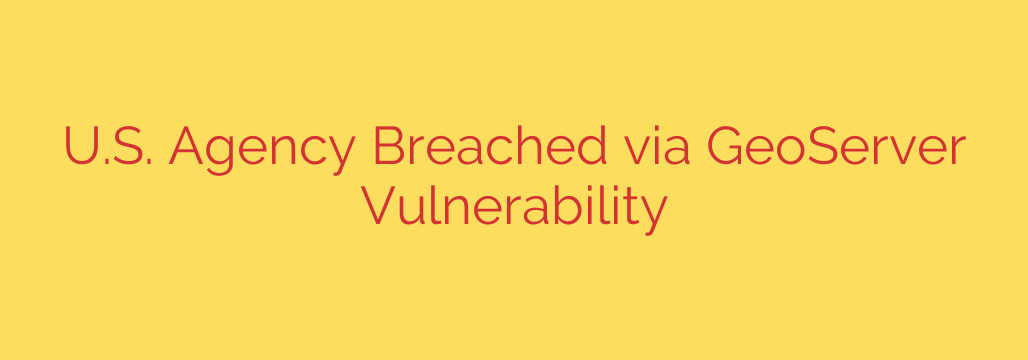
Critical GeoServer Flaw Exploited in U.S. Agency Breach: What You Need to Know
A recent cybersecurity incident has underscored a critical lesson for organizations everywhere: even specialized, open-source software can become a gateway for sophisticated attackers. A U.S. federal agency recently suffered a significant data breach after threat actors exploited a known vulnerability in GeoServer, a popular open-source server for sharing and editing geospatial data.
This attack serves as a powerful reminder that any internet-facing system, regardless of its function, is a potential target. Understanding how this breach occurred is essential for any organization looking to secure its own infrastructure.
Unpacking the GeoServer Vulnerability: CVE-2023-25157
The security flaw at the heart of this breach is identified as CVE-2023-25157. This is not a minor bug; it’s a critical remote code execution (RCE) vulnerability. In simple terms, this flaw allowed attackers to send specially crafted data requests to the server, tricking it into executing malicious commands.
This gave them a direct foothold into the agency’s network, bypassing many traditional security measures. The vulnerability affects GeoServer versions up to 2.21.4 and 2.22.2, and while a patch has been available for some time, unpatched systems remain dangerously exposed.
Anatomy of the Breach: How the Attack Unfolded
Cybersecurity analysts believe the attack followed a common but effective pattern. The threat actors likely began by scanning the internet for public-facing, unpatched GeoServer instances. Once a vulnerable server belonging to the agency was identified, they exploited CVE-2023-25157 to gain initial access.
From there, the attackers were able to:
- Install a web shell: This malicious script provides persistent remote access, allowing them to issue commands and navigate the compromised network at will.
- Move laterally: The initial foothold on the GeoServer machine enabled the attackers to explore the internal network, searching for other valuable systems and data.
- Exfiltrate data: The ultimate goal was achieved when the attackers located and stole sensitive government data from the compromised network.
This methodical approach highlights how a single vulnerability in one application can compromise an entire network.
The Impact and Implications for Government and Enterprise
While the full extent of the data exfiltrated has not been publicly detailed, the implications are serious. Geospatial data can include sensitive information about critical infrastructure, environmental conditions, and logistical planning.
This breach serves as a stark reminder that any internet-exposed system can be a target. It highlights the critical need for robust security protocols, not just for mainstream enterprise software but for specialized, open-source tools as well. Many organizations fail to apply the same level of security scrutiny to these applications, creating dangerous blind spots.
Actionable Security Measures: How to Protect Your Organization
To prevent similar attacks, organizations using GeoServer or other web-facing applications must adopt a proactive security posture. Here are essential steps to take immediately:
Patch Immediately: This is the most crucial step. If you are running a vulnerable version of GeoServer, update to version 2.21.5, 2.22.3, or higher without delay. Assume that your system is being actively scanned for this flaw.
Conduct Regular Vulnerability Scanning: Proactively scan your external and internal assets for known vulnerabilities. Automated tools can help identify outdated software and misconfigurations before attackers do.
Implement Network Segmentation: Do not place web-facing servers on the same flat network as critical internal systems. Segmenting your network ensures that even if an external server is compromised, the attacker’s ability to move laterally is severely limited.
Harden Web-Facing Applications: Reduce the attack surface by disabling unnecessary features and services. Place web applications behind a Web Application Firewall (WAF), which can help filter and block malicious requests before they reach the server.
Monitor and Log Activity: Implement robust logging and monitoring on all servers. Keep an eye out for unusual network traffic, unexpected processes, or unauthorized login attempts. This can provide an early warning of a potential compromise.
This breach of a U.S. agency is more than just a single incident; it’s a clear warning about the evolving threat landscape. Attackers are actively targeting all types of software, and a failure to maintain diligent patch management and security hygiene can have severe consequences. The single most important defense is vigilance. By prioritizing timely updates, continuous monitoring, and a defense-in-depth strategy, organizations can significantly reduce their risk of becoming the next headline.
Source: https://securityaffairs.com/182532/hacking/how-threat-actors-breached-u-s-federal-civilian-agency-by-exploiting-a-geoserver-flaw.html








